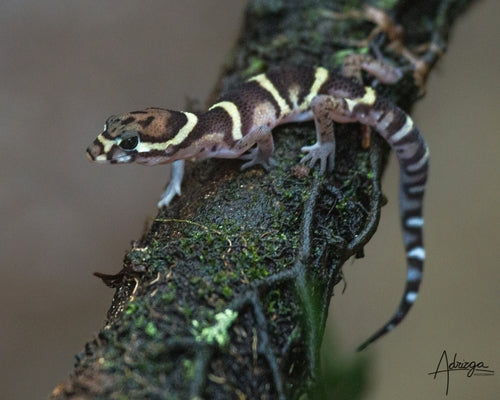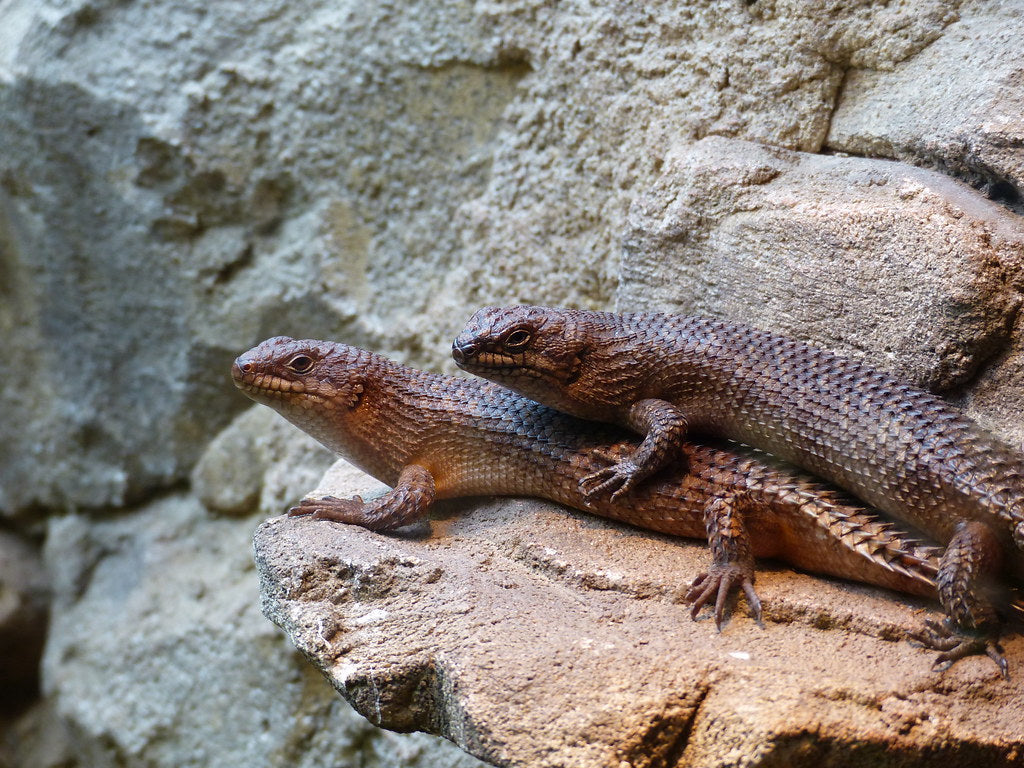Peters banded skinks (Scincopus fasciatus) are small, nocturnal, terrestrial lizards primarily native to the southern border of the Sahara desert in Africa. Their habitat features sandy, sometimes stony soil, scrubby or grassy vegetation, and arid conditions.
Peters banded skinks are generally 5-7” long, with a tapered head, large black eyes, long body, smooth scales, short toes, and a short, tapered tail. They are orange on top and pale beneath, with several broad black bands across their back and tail.
Not much is known about getting Peters banded skinks to breed in captivity, much less thrive, so this is an advanced-level pet reptile. The information in this care sheet is based on what little we do know, plus habitat data and comparisons to similar species.
How much space do Peters banded skinks need?
A single Peters banded skink should be housed in no smaller than a 40 gallon (36” x 18” x 16”) terrarium. Of course, larger is likely to be used if provided, and highly recommended as one way to increase your pet’s quality of life in captivity.
Cohabitation (keeping multiple Peters banded skinks in the same terrarium) is not recommended, as this species does not seem to be naturally social.
Do Peters banded skinks need UVB?
Peters banded skinks are nocturnal, which means that they are most active from dusk to dawn. Because not much is known about their husbandry requirements, it’s best to play it safe and provide an appropriate amount of high-quality UVB lighting. Aside from helping provide a day/night cycle, UVB is also good for your skink’s overall wellbeing.
The best UVB bulbs for Peters banded skinks are:
- Arcadia ShadeDweller kit
- Zoo Med T5 HO Reptisun 5.0
The UVB bulb should be roughly half the length of the enclosure and housed in an Arcadia or Vivarium Electronics fixture with a reflector. Place the fixture on the basking side along with the heat lamp. If the lamp is placed over mesh, then it should be 11-13” above the basking surface. If not obstructed by mesh, then it should be 14-16” above the basking surface.
UVB is blocked by glass and plastic, so you can’t give your skink UVB by placing its terrarium in front of an open window. This can also make your enclosure dangerously hot by creating a greenhouse effect! Also make sure that the fixture your UVB bulb is in does not have a clear plastic or glass bulb cover.
Lights should be on for 11 hours/day during winter, and 13 hours/day during summer to simulate seasonal changes in day length.
What basking temperatures do Peters banded skinks need?
Peters banded skinks should have a warm hide temperature of 90-95°F, as measured by a digital probe thermometer with the probe placed inside the warm hide. There should also be a cooler area on the opposite side of the enclosure that stays between 75-80°F.
It’s best practice to provide heat for your skink with two sources: a heat lamp and a heat mat. The heat lamp is for warming the air of the enclosure and providing short-wavelength infrared (heat) for the skink to use as desired. The heat mat is for heating the warm hide to optimal temperature.
For the heat lamp, use a low-wattage white heat bulb placed on one side of the enclosure. If it's too warm, try a plug-in lamp dimmer — the air of the basking area should not get above 100°F. If it's too cool, you need a higher-wattage bulb. Do not use ceramic heat emitters (CHEs), red bulbs, or blue bulbs, as these are not as effective. Place the skink’s warm hideout/cave below the heat lamp.
If your warm hide doesn’t get warm enough with the heat lamp alone, you will need a heat mat. The heat mat should be roughly the same size or a little larger than the hide itself, placed under the hide and covered with enough substrate to prevent direct contact. You must plug your heat mat into a thermostat to prevent it from overheating, which can be fatal! Place the thermostat probe inside the warm hide to accurately control temperature.
Heat sources should be turned off at night. Nighttime temperatures can drop as low as 65°F.
What humidity levels do Peters banded skinks need?
Peters banded skinks need a low-humidity environment with access to a humid microclimate for best health. Average humidity should be below 50%, as measured by a digital probe hygrometer with the probe in the middle of the terrarium.
However, you will also need to provide a humid hideout lined with moistened substrate and placed on the cool end of the enclosure. The humid hideout should have 70% humidity or higher at all times.
What substrate is good for Peters banded skinks?
Substrate covers the floor of your skink’s terrarium and helps make the enclosure more attractive, but it also cushions your skink’s body and provides something for them to dig in. It’s ideal to use a substrate that imitates the “substrate” that the reptile naturally lives on in the wild. For Peters banded skinks, that means it should be sand or sandy soil. It should have small particles, hold moisture well, and be loose enough to dig in.
We recommend the following substrates for Peters banded skinks:
- Zoo Med ReptiSand
- Exo Terra Desert Sand
- Exo Terra Stone Desert
Substrate should be at least 4” deep and completely replaced every 3-4 months. Remove poop and urates daily, along with contaminated substrate.
What decor can you use in a Peters banded skink terrarium?
It’s terribly boring (and stressful!) for a lizard to be stuck in an enclosure with nothing in it except substrate and food/water bowls. It doesn’t matter how big the enclosure is if you don’t put things in it for your pet to use and interact with.
Here are some ideas:
- small logs and branches
- climbing rocks
- additional hides
- live or artificial plants
Rocks should be rested on the bottom of the enclosure, not on top of the substrate. This prevents your skink from getting crushed if it digs underneath.
It’s also best practice to cover three sides of the enclosure to help the skink feel more secure in its environment!
What do Peters banded skinks eat?
Peters banded skinks are primarily insectivorous, which means that they need to eat insects (preferably live) in order to get the nutrition that their bodies need. However, they are known to eat some plants as well.
How often and how much they need to eat depends on age. Juveniles should be fed daily, with adults fed every 2-3 days. Offer as many insects as they can eat in a 5-minute period. Vegetables can be offered daily. Fruit should be used as a treat.
Feeder insects for Peters banded skinks: dubia roaches, discoid roaches, crickets, black soldier fly larvae, hornworms, mealworms, superworms
Vegetables for Peters banded skinks: collard greens, cactus pads, spring mix, arugula, kale, pea shoots, alfalfa, bok choy, carrot greens, spinach, dandelion greens/flowers, hibiscus leaves/flowers
Fruits for Peters banded skinks: berries, fig, apple, prickly pear, papaya, mango
Supplements
You will need calcium and vitamin supplements to help prevent your lizard from developing a deficiency. We recommend Repashy Calcium Plus LoD, lightly dusted on all of your lizard’s feeder insects. It’s okay to skip a dusting every once in a while.
Water
Provide a small water bowl where your lizard can always get a drink when needed. Change the water daily and scrub the bowl with a reptile-safe disinfectant weekly, or whenever it becomes soiled.
Do Peters banded skinks like to be handled?
Few reptiles actually “like” to be held, but Peters banded skinks are reported to be fairly calm and tame down well. Leave your skink alone for the first 2-3 weeks or until it’s eating regularly and seems confident in its new enclosure.
When you begin handling, don’t grab the skink from above — instead, approach from the side and scoop from below. Support as much of its body as possible, especially its feet. Start with very short handling sessions in the beginning, then gradually make them longer as your pet becomes more accustomed to you.
One way to start teaching it to trust you is by hand-feeding it with a pair of feeding tweezers.
*This care sheet contains only very basic information. Although it’s a good introduction, please do further research with high-quality sources to obtain additional information on caring for this species.



Leave a comment
This site is protected by hCaptcha and the hCaptcha Privacy Policy and Terms of Service apply.